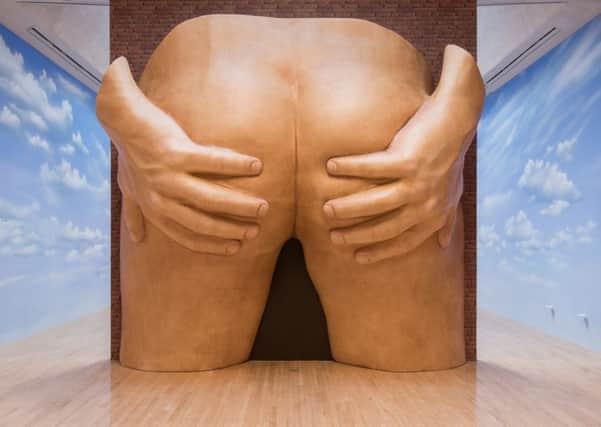Art review: Turner Prize 2016


As a responsible journalist, one who values words and wit, I really should begin my Turner Prize 2016 review with a bottom joke. Everyone else is doing it. Project for a Door (After Gaetano Pesce) Anthea Hamilton’s vast sculpture of a rear end at Tate Britain, has been a gift to picture editors and headline writers the world over.
Hamilton’s work, a bare bottom, legs akimbo, set in a brick facade is based on a proposal from 1972 by the renowned architect and designer Gaetano Pesce, for the door to a swanky Park Avenue apartment block in New York. You might view it as an entrance or an exit. The work, from a man renowned for “soft” design that emphasises the human body and a period of hedonism in the city, was never realised.
Turner Prize 2016 ****
Tate Britain, London
Advertisement
Hide AdAdvertisement
Hide AdHamilton, an artist who quotes and reworks slyly from others has rescued it from oblivion. The original is said to have been modelled on a well-known architect. When Hamilton devised the work for her New York show at SculptureCenter New York it was modelled on an un-named “cultural figure”. In London, Tate curator Linsey Young, who cut her curatorial teeth at Edinburgh’s Inverleith House and the Scottish National Gallery of Modern Art, has diplomatically refused to reveal the identity of the original owner of what are now a pair of 18-foot high polystyrene cheeks.
What to make of Hamilton’s two room-sized installations? They also quote Magritte’s powder blue skies, with a room where the walls are a vast skyscape of the view at 3pm on a June day from the artist’s own London window. Hamilton also sets a suspended brick suit, in a style beloved of both John Paul Gaultier and your own local joke shop, against faux-brick wallpaper that recalls Magritte and Warhol as well as SculptureCenter’s red-brick walls.
Hamilton is a sophisticated artist of both illusion and allusion, but I’ve never quite found I can grasp what her slippery sculpture of fakes and remakes is saying. Perhaps she replays the distance with which we view the glittering ephemera of pop culture. Like the beautifully chilly cut glass rice cakes that sit around the gallery space, I admire the form but can’t quite taste the fibre.
This, though, is a good Turner Prize year, sculptural, serious. In Josephine Pryde’s exhibition, a toy train sits on its tracks. A replica in miniature of a diesel locomotive, it is the rollercoaster ride of art tourism, perfect for the week of the Frieze Art Fair, in which the international art collectors come to town (although none of the gazillionaires I saw looked like they ever travelled by anything but private jet or limousine). The artist Sophie Calle once devised a typology of gallery viewers. There was, for example, the ever-moving fish, or the flighty butterfly. Pryde, an academic as well as an artist, who lives and works in London and Berlin, suggests that we are stalled in a siding.
The two strongest artists in the exhibition wrestle with the problems of making and meaning as though they have just been invented. Presented in the same exhibition, Helen Marten and Michael Dean complement each other like the ego and the id, one the cool, pragmatic mind, the other the process-based primitive.
Marten, at just 30, is an exceptional artist whose sculptural works are amongst the closest things I’ve seen to devising a language of three-dimensional form to deal with our formless culture. Unlike many contemporary artists working with the social or political implications of tech, Marten seems to wrestle with what our flat screen world has done to our brains, now that super new technologies simulate every sensation.
Marten’s sculptures are clusters of ephemera that are assembled on and around settings that are modular, eerily familiar and unfinished, like the bargain corner of Ikea. Their conjunctions are wordless puzzles, so grooved fibreboard might sit next to a cast of a tea pot that is itself imitating a walnut shell. Where is the kernel, what is the husk? One installation that includes leather soles, clumsily made knives, fish and snakeskin sits next to the odd façade of what might be a doll’s house. What is inside and what is out? Marten reminds us that these days everything feels like a cold, shiny touchscreen and questions what lies between us and the world now that a skin is not something we inhabit but something we wrap around our iPhones. Ceramics dangle from a wall, echoing our internal networks. What is essential, immoveable plumbing, and what might be the new neural pathways? Marten’s work is endlessly rich, mystifying and right for our times.
Advertisement
Hide AdAdvertisement
Hide AdMichael Dean’s dazzling white room full of sculpture feels thrillingly brawny, all friction and traction. A reworking of his much-lauded exhibition Sic Glyphs at South London Gallery, his sculptures have their origins in the written and printed word, home-made typographies squeezed and stretched into sculptural form. This is a confrontational installation of boards and tall human-sized corrugated forms, squeezed cement sculptures that riff on the techniques of “shuttering” concrete and the metal shutters that describe our empty high streets. Dean is fond of the word shore: the debris of washed up forms, and the idea of shoring, holding something rickety and unstable upright. His upright monoliths feel urban, provisional, but weirdly ancient: a Stonehenge of austerity Britain.
I’d be very happy if either of these two excellent artists won. Not least because I’ll be able to avoid bringing up the rear.
*Until 2 January 2017